On-going Research Projects
Many of our tasks ask children to learn new words -- in games, on the computer, or by viewing slides. We do this to understand how learning works and how it can be made easier. We are also interested in real world, everyday learning in naturalistic settings.
In the past, we (and lots of other researchers) followed young children around with cameras and clipboards, trying to understand their every day learning experiences. But these techniques just allow us to see the child in the world, they don't show us the child's world in the sense of what the child sees. In very exciting new research, we are putting lightweight head-cameras on children, a first attempt to see the world as they do.
Below is a list of our current studies and the ages that researchers are seeking for participation. We hope you find a study that excites you and sends you eagerly to filling out our on-line participation form.
Toy Play Study
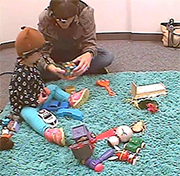 Researchers: Hadar Karmazyn, Erin Anderson
Researchers: Hadar Karmazyn, Erin Anderson
Ages needed: 10 - 30 months
Visits: in-home, once a day for one week
COVID policy: To ensure parent and child safety, this study will be conducted in participants' homes, without a researcher present. The cameras and toys are disinfected and set aside for at least 24 hours in between participants.
Study description: We want to understand how parents and infants play with spatial toys like blocks and nesting cups. Parents and infants will each be given headband with a lightweight camera to place on their infant's head during the play session, providing a first-person perspective of their visual experience during the session. Studying the visual environments of infants during spatial play may help us understand how infants learn about relationships between objects, like "over / under", "in / on", or "in front / behind".
Understanding Changes in Physiology During Play
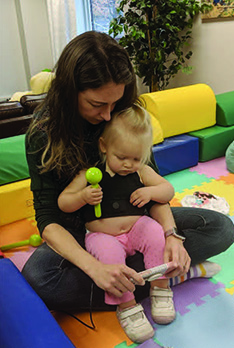 Researchers: Jeremy Borjon
Researchers: Jeremy Borjon
Ages needed: 8-12 months
Visits: one-time visit
Study description: A new, developing branch of research in the lab is seeking to understand how changes in your infant's heart rate and breathing help them to learn and play. These studies use a new, lightweight vest designed right here in Indiana University to wirelessly measure your child's heart beats, breathing, and movement using cloth sensors.
Early Visual Environments of Infants and Toddlers and the Homeview Project
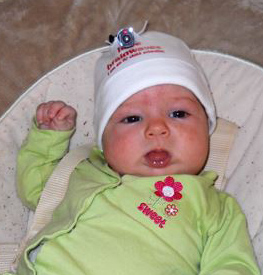
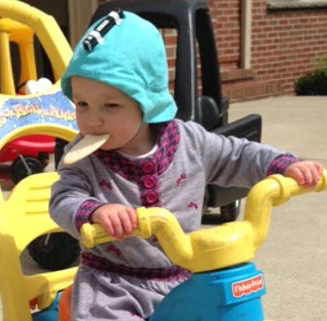 Researchers: Swapnaa Jayaraman, Jeremy Borjon, Elizabeth Clerkin, Hadar Karmazyn
Researchers: Swapnaa Jayaraman, Jeremy Borjon, Elizabeth Clerkin, Hadar Karmazyn
Ages needed: 0 - 24 months
Visits: 2 visits - to obtain, then return head camera
Study description: We want to understand what is in the visual environments of infants and toddlers, and whether they change across the first two years of life. We give parents a soft cap - with a light-weight camera sewn in - to place on their infant's head. Parents are asked to turn the camera on whenever the infant is awake to record the natural scenes in their infant's everyday lives. Statistical regularities in visual environments are deeply connected to the visual system. Characterizing and quantifying the early visual environments of infants and toddlers may help us understand how the visual system gets built.
Parent and Child Joint Play
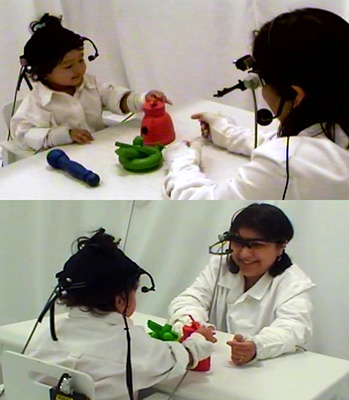 Researchers: Linger Xu Jeremy Borjon Sara Benham
Researchers: Linger Xu Jeremy Borjon Sara Benham
Ages needed: 9 - 36 months
Visits: one-time visit
Study description: In this study we want to understand how infants learn about new words and objects and how they develop their social interaction skills while playing with their parents. This toy-play interaction is one of the most common everyday activities in the infants' lives and gives us a valuable representation of how learning happens in the real world. During the study, we will put light-weight head-mounted eye-trackers on both the infant's and parent's forehead to see the learning unfolds from the infant's point of view and examine how all types of parent's social cues (such as hand actions, speech, looks, body movements, etc.) influence the infant's behavior and learning in real time.
Object Training Study
![]() Researcher: Elizabeth Clerkin
Researcher: Elizabeth Clerkin
Ages needed: 17 - 20 months
Visits: 6 visits, once per week for 6 weeks
COVID policy: This study is currently on hold due to an inability to social distance during the sessions. Please stay tuned as we hope to be up and running again soon!
Study description: We want to understand how playing with different types of toys affects children's learning of novel object names. At each session, experimenters fit the child with a lightweight eye-tracking headband, and the child plays with novel toys and an experimenter. At some sessions, the child is also asked to point to pictures of objects in a book or to indicate which objects they think have the same name. We want to see how each child's visual attention to the toys across the play sessions is related to their vocabulary and to how they choose to apply names to objects they have not seen before.
Back to the top
